
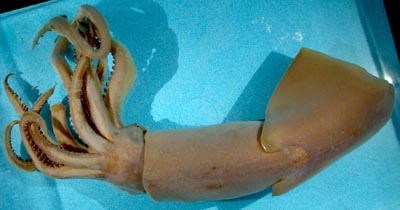
Figure. Dorsal view of A. lichtensteini, type B, 145 mm ML, preserved, 21°35'S, 02°00'W, USNM specimen. Photograph by R. Young.
- Tentacles
- Terminal pad of club with 16-17 (Kubodera, et al., 1998) or 15-18 (Pfeffer, 1912) small suckers.
- Club with double series of hooks; marginal suckers absent.
- Club with 19-24 hooks (Pfeffer, 1912), 20-21 hooks (Kubodera, et al., 1998).
- Carpal pad with 9-12 suckers (Pfeffer, 1912), 9-10 suckers (Kubodera, et al., 1998).
- Club length 30-40% of ML (Pfeffer, 1912), 30% of ML (Kubodera, et al., 1998).
- Arms
- Length 75% (Naef, 1921-23) or 40-53% (Kubodera, et al., 1998) or 67-75% (Pfeffer, 1912) of the ML.
- Arms subequal but slight differences give the formula 2>3>4>1 (Naef, 1921-23).
- Head
- Funnel groove with V-shape (see title photograph on first page).
- Beaks
- Beaks are very different from those of Onychoteuthis. The upper jaw has a long, slender rostrum; the jaw angle is rounded and obtuse. The lower beak has an accessory tooth (not visible in side view) and a lateral wall ridge (Naef, 1921-23).
- Radula
- The radula has a tricuspid rhachidian and a distinctly bicuspid lateral tooth 1.
- Mantle
- Posteroventral mantle keel present.
- Fins
- Fins sagittate, attenuated posteriorly.
- Length 60-68% of ML (Pfeffer, 1912).
- Width 48-68% of ML (Pfeffer, 1912).
 Click on an image to view larger version & data in a new window
Click on an image to view larger version & data in a new window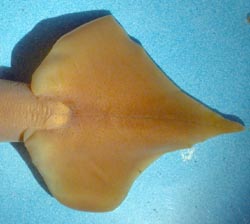
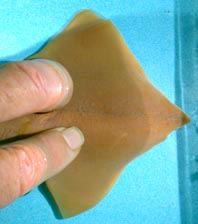
Figure. Left - Dorsal view of fins, A. lichtensteini type A, 110 mm ML, 20°27'N, 21°58'W, USNM 294756. Photograph by R. Young. Right - Dorsal view of fins, A. lichtensteini type B, 145 mm ML, preserved, 21°35'S, 02°00'W, USNM specimen. The photographs show the variation in the shape of the fins between two Atlantic Ocean squid. The squid on the right with the peculiar rhomboidal fin is the squid pictured in the title photograph of this page. Photograph by R. Young.
- Gladius
- Gladius not visible on dorsal side of mantle (i.e., mantle completely surrounds gladius).
- Thick midrib of rhachis present only in posterior half of gladius.
- Rostrum long (14-15% of ML) and laterally conpressed (Pfeffer, 1912), but more massive, less firm and more cartilagenous than in Onychoteuthis (Naef, 1921-23).
- Vanes of gladius very narrow or absent.

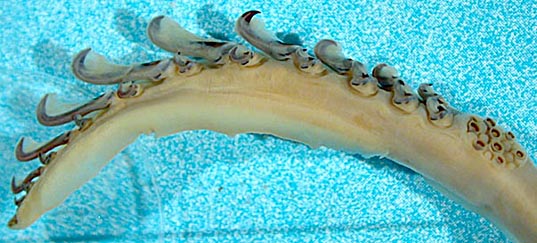

Figure. Views of the club of A. lichtensteini type A. Top - Dorsal view, 110 mm ML, USNM 294756. Photograph by R. Young. Bottom - Oral view, 145 mm ML, Mediterranean Sea. Drawing from Pfeffer, 1912.
Scanning electron micrographs of the club hooks can be found here.
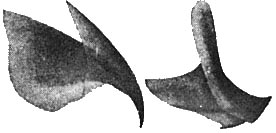
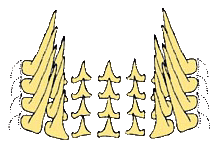





 Go to quick links
Go to quick search
Go to navigation for this section of the ToL site
Go to detailed links for the ToL site
Go to quick links
Go to quick search
Go to navigation for this section of the ToL site
Go to detailed links for the ToL site